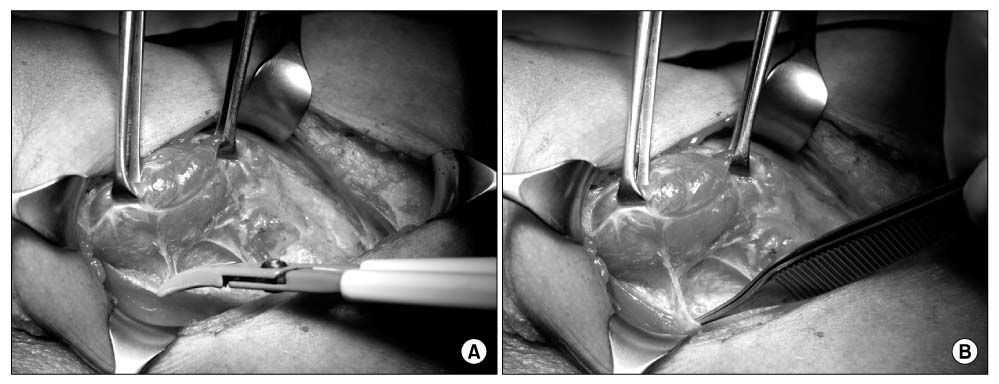J Korean Surg Soc.
2009 Mar;76(3):149-153. 10.4174/jkss.2009.76.3.149.
A Comparison of Conventional Thyroidectomy and LVSS Thyroidectomy: The Feasibility of the LVSS in the Thyroid Operation
- Affiliations
-
- 1Department of Surgery, Research Institute for Medical Sciences, College of Medicine, Chungnam National University, Daejeon, Korea. kimjr@cnuh.co.kr
- 2Department of Pathology, Research Institute for Medical Sciences, College of Medicine, Chungnam National University, Daejeon, Korea.
- KMID: 2096536
- DOI: http://doi.org/10.4174/jkss.2009.76.3.149
Abstract
- PURPOSE
Recently, Ligasure vessel sealing system (LVSS) is being introduced in thyroid operations. In this study, we compare the clinical outcomes of LVSS using thyroidectomy with those of conventional thyroidectomy.
METHODS
From Nov 2006 to Oct 2008, 400 patients managed with total thyroidectomy were investigated. Half of them (the conventional group) were operated on with conventional methods, whereas another half (the LVSS group) were operated on using LVSS. Operation time, amount of drainage, duration of drainage, hospital stay, and complications (numbness, hoarseness, hematoma) of the two groups were compared.
RESULTS
The mean operation time of the LVSS group was 87.53+/-27.49 (min), and that of the conventional group was 120.48+/-39.51 (min). Therefore, operation times of the LVSS group was significantly shorter than that of the conventional group (P<0.001). But, there was no significant difference in the amount of drainage, duration of drainage, duration of hospital stay, and the incidences of complications.
CONCLUSION
Our studies show the effectiveness and safety of LVSS in thyroid operations. We advocate the application of LVSS to thyroid operations.
Keyword
MeSH Terms
Figure
Cited by 1 articles
-
A Comparison of the Usefulness and Safety of the HarmonicTM Scalpel, LigasureTM System, and Classic Clamp-and-Tie Technique for Hemostasis during Thyroid Surgery
Jeong-Mi Yu, Jae-Eun Han, Yong-Hoon Kim, Je-Ryong Kim
Korean J Endocr Surg. 2009;9(4):206-210. doi: 10.16956/kjes.2009.9.4.206.
Reference
-
1. Lachanas VA, Prokopakis EP, Mpenakis AA, Karatzanis AD, Velegrakis GA. The use of Ligasure Vessel Sealing System in thyroid surgery. Otolaryngol Head Neck Surg. 2005. 132:487–489.2. Heniford BT, Matthews BD, Sing RF, Backus C, Pratt B, Greene FL. Initial results with an electrothermal bipolar vessel sealer. Surg Endosc. 2001. 15:799–801.3. Horgan PG. A novel technique for parenchymal division during hepatectomy. Am J Surg. 2001. 181:236–237.4. Palazzo FF, Francis DL, Clifton MA. Randomized clinical trial of Ligasure versus open haemorrhoidectomy. Br J Surg. 2002. 89:154–157.5. Belli G, Fantini C, Ciciliano F, D'Agostino A, Barberio M. Pancreaticoduodenectomy in portal hypertension: use of the Ligasure. J Hepatobiliary Pancreat Surg. 2003. 10:215–217.6. Sengupta S, Webb DR. Use of a computer-controlled bipolar diathermy system in radical prostatectomies and other open urological surgery. ANZ J Surg. 2001. 71:538–540.7. Dubuc-Lissoir J. Use of a new energy-based vessel ligation device during laparoscopic gynecologic oncologic surgery. Surg Endosc. 2003. 17:466–468.8. Prokopakis EP, Lachanas VA, Karatzanis AD, Benakis AA, Velegrakis GA. How we do it: application of Ligasure Vessel Sealing System in patients undergoing total laryngectomy and radical neck dissection. Clin Otolaryngol. 2005. 30:198–201.9. Gluckman JL. Bailey BJ, Calhoun KH, editors. Total thyroidectomy. Atlas of Head and Neck Surgery: Otolaryngology. 2001. 2nd ed. Philadelphia: Lippincott Williams & Wilkins;228–229.10. Kennedy JS, Stranahan PL, Taylor KD, Chandler JG. High-burst-strength, feedback-controlled bipolar vessel sealing. Surg Endosc. 1998. 12:876–878.11. Harold KL, Pollinger H, Matthews BD, Kercher KW, Sing RF, Heniford BT. Comparison of ultrasonic energy, bipolar thermal energy, and vascular clips for the hemostasis of small-, medium-, and large-sized arteries. Surg Endosc. 2003. 17:1228–1230.12. Klioze SD, Poppas DP, Rooke CT, Choma TJ, Schlossberg SM. Development and initial application of a real time thermal control system for laser tissue welding. J Urol. 1994. 152:744–748.



